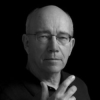Sam Abell

Sam Abell
Sam Abellis an American photographer known for his frequent publication of photographs in National Geographic. He first worked for National Geographic in 1967, and is one of the more overtly artistic photographers among his magazine peers. Sam Abell's style of photography is documentary in the sense that his major avenue, the National Geographic magazine, is a publication of record. However, his best work is known for its transcendent qualities, starting at the documentary level yet open to interpretation on an...
NationalityAmerican
ProfessionPhotographer
CountryUnited States of America
I'm very involved in photographing America now, so I don't think of faraway places, as I did when I was young.
The thing with my workshops is, photography is a thoughtful process. In an atmosphere of fast photography, and generally thoughtless, quick, automatic photography, I think that there is an interest in the slowed down, thoughtful approach.
Even though I teach with 35mm, my method takes people by surprise, because it isn't fast, and it isn't about hardware or software, or even great results. It's about great process.
My connection to Santa Fe is very closely, and continuously a connection with Reid. I believe in him and his philosophy of photographic education.
There are things that I teach, about building photographs, and that's why people come to my workshops. When people come to the workshops, they're consumed with seeking the subject, and I teach seeking the setting.
I did it once, and National Geographic recruited me. I did it primarily out of curiosity. A lot of legendary photographers had worked on that campaign. Ernst Haas had done the early photography, and I knew him. There's a lore in photography about that campaign, and I was curious.
I did a story for the Geographic on Meriwether Lewis and William Clark, and Stephen Ambrose was the writer. He said, "I've got the easiest job in the world. I just have to re-tell the story of the greatest fishing, camping, hunting, canoeing trip of all time. You, Sam, have the hardest job, which is, pretend like nothing has happened in the last 200 years.
I started teaching in '76 and I'd been a photographer at the Geographic for six years. But prior to being at the Geographic I was a teacher. Plus my parents were teachers and my brother and my grandparents. So it was the culture of our family to think about teaching, to talk about teaching, to talk about teachers.
The longer we lived with it the more we wanted something less about process and more about life.
It's a little bit like talking about the life of writing. The life of writing may be about many things, but it always begins with the writer. With the kernel of an idea, or a character, or an idea or a theme, or even an outcome. But for documentary photographers, photographs begin at that intersection of the real world and the imaginative inner world.
There are a lot of ways to talk about the life of a photograph. You can talk about the afterlife of a photograph, and in the end I talk about that, with the Richard Prince picture. But mainly, what I dedicated the book to being about was how photographs begin their life, and where they begin it. And they begin it with the photographer's imagination and instinct and experience.
I was giving a lecture and I said, that's enough about The Photographic Life, meaning my biography, now let's talk about the life of a photograph. And in that one instant I got the title for a potential next book.
My dad had been an ardent amateur photographer, and he taught me to compose a photograph from the back to the front, and then populate the picture.
In almost every photograph I have ever made, there is something I would do to complete it. I take that to be the spirit hole or the deliberate mistake that's in a Navajo rug to not be godlike, but to be human.